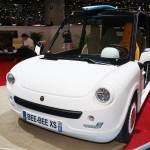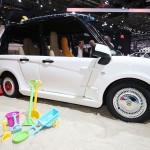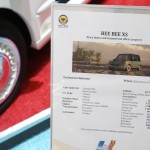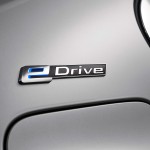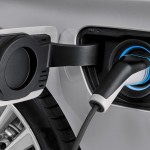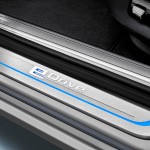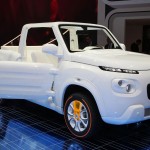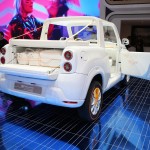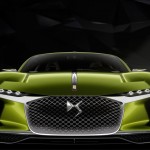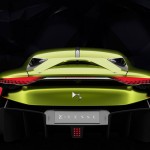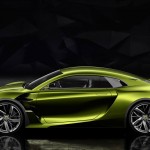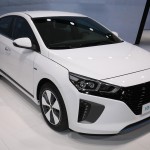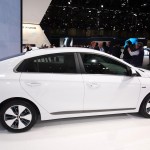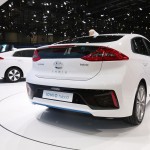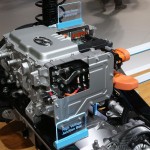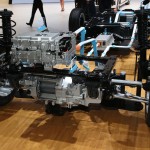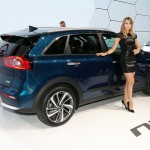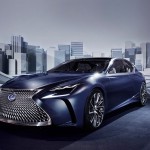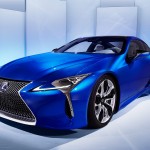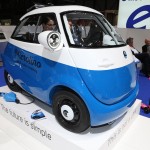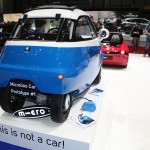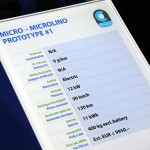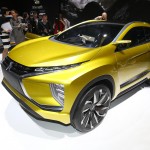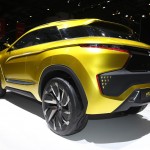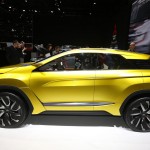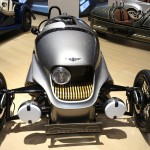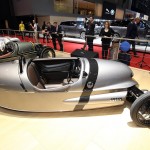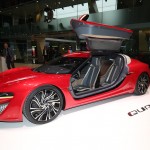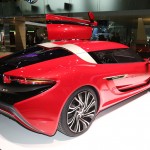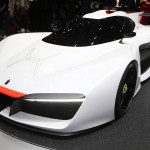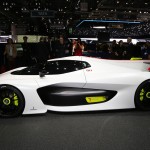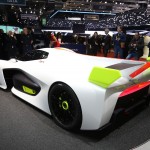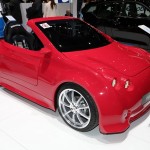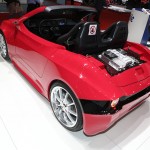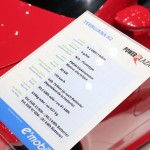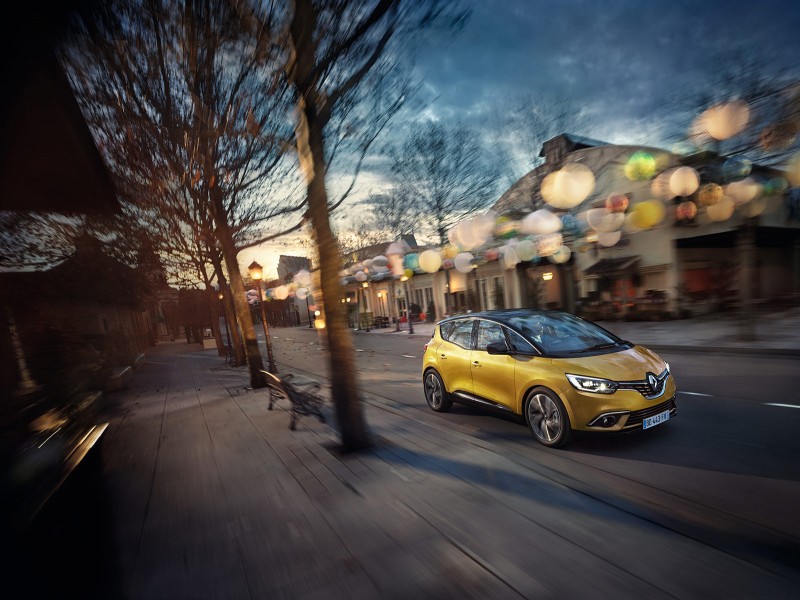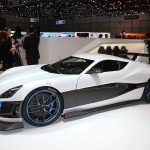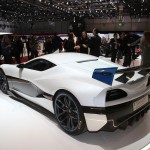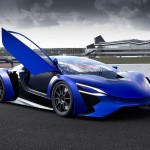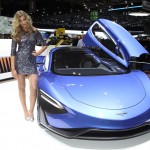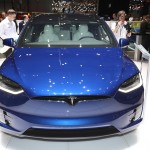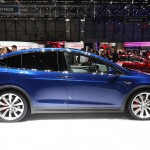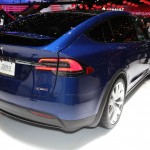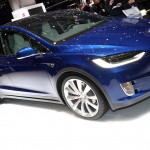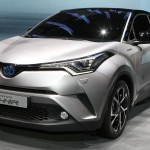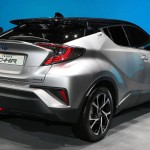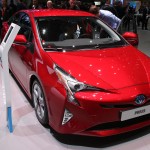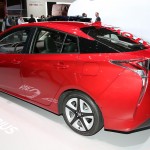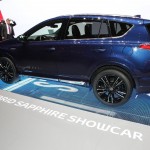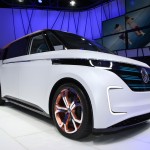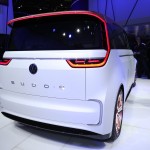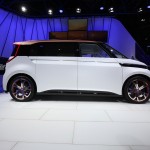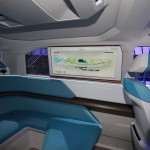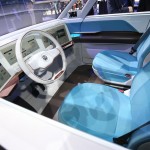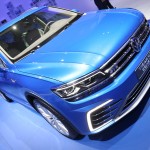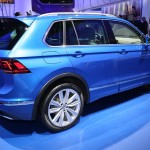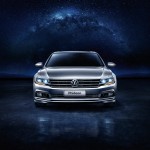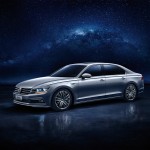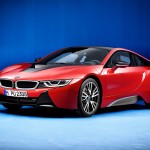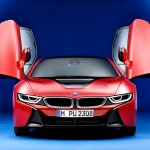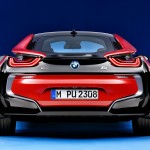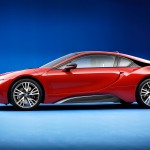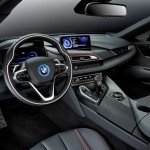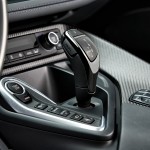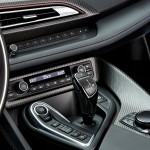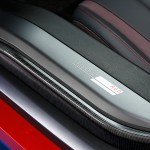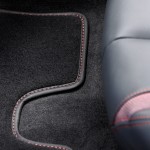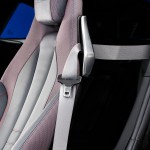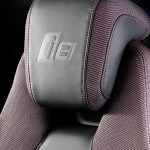Bee Bee XS
This French frolic certainly bears an uncanny design resemblance to the original Citroen Mehari and Renault Rodeo. It sports a neat open top design with the emphasis on “lightness” – unladen vehicle weight is just 660 kilos yet it sports a 9.6kWh battery, enough to travel a little more than 65 miles (110kms). This cute and fun electric car is priced from €22,900 – or about £17,695 – excluding doors, which are a further €992 (£766) for four. As one would expect for a car of this type, bike racks and roof bars are included on the price list as optional extras, although it must be one hell of a bike rack as it costs €408 (£315)!
BMW
BMWi technology will officially make its mark on the regular BMW branding with a new iPerformance designation attached to models in the main BMW line-up. The name will be given to all BMW plug-in hybrid vehicles from July 2016, starting with the plug-in hybrid variants of the new BMW 7 Series, e.g. the BMW 740e iPerformance.
The iPerformance models will benefit from the transfer of technical expertise regarding electric motors, battery cells and electronic control systems. Visible indicators, meanwhile, are a BMW i logo on the front side panel, BMW i-style blue elements in the kidney grille and wheel hubs, and an eDrive logo on the C-pillar. Customers can also make use of the BMW i 360° ELECTRIC range of products and services, including the BMW i Wallbox.
Citroen
Citroen has been a quiet contender in the electric vehicle market since their C-Zero (jointly produced as the Mitsubishi i-Miev and Peugeot Ion) first hit the market. That car was never hugely popular, both because it came out at a time when electric cars were not in vogue and because it’s rudimentary offering was based on a small and frankly quite forgettable city car. This then, is the antithesis of that as it is as bonkers a Citroen as one could ever have hoped for. The e-Mehari is an electric version of Citroen’s famed innovative open top pickup-come-do-it-all car that you might have seen when on holiday in the South of France. The original used a sandwich of plastic and foam to form its body panels that also featured a corrugated design for added strength. This new version doesn’t appear to be quite so innovative but it is nonetheless an eye-catching EV.
DS Automobiles
DS Automobiles, the off-shoot company from Citroen that has branched away from the main offerings of Citroen, providing more bespoke, premium and luxury products has come out with a tease of their latest concept and it’s electric.
Perhaps not too surprising, given electric concepts are coming thick and fast to motor shows of late and given that DS Automobiles partnered with Virgin Racing in the all-electric Formula E championship. An electric direction was inevitable as was, arguably, a sporty one too given the team’s sporting prowess in FE.
The new concept gives a glimpse of the future in the form of an electric supercar. The concept will break cover properly at the 2016 Geneva Motor Show next week. Named the DS E-TENSE, the concept aims to showcase not only DS Automobile’s electric powertrain but also a host of technology and hi-tech capability. Read more here…
Hyundai
Easily overlooked when amongst the plethora of whacky concept cars, super cars and other assorted assets on show, the Hyundai Ioniq quietly made its global debut at the 2016 Geneva Motor Show. However, it is, perhaps, one of the most important cars on display and possibly the most likely car amongst all these on this page that will commonly be seen on a road near you. Rather disrespectfully to Hyundai, it is being dubbed as their Prius-fighter, a term coined to suggest that it is Hyundai’s rival to the popular mild-hybrid. And there’s some truth to that, but actually it’s a whole new approach that’s far removed from Toyota’s arguably staid approach to hybrids. For example, where Toyota has been extremely good at keeping costs low and using NiMH batteries, the Ioniq uses lithium-ion. Yes, Toyota used Li-ion in their Plug-in Prius and the Prius+, but they’ve largely been cautious when it comes to truly changing their well-proven mild hybrid tech. Hyundai, on the other hand, had nothing to lose and have gone into the hybrid world guns blazing. More convincingly, while there’s no EV in the Toyota camp, the Ioniq is the first car to be offered as electric, plug-in hybrid and mild hybrid. It’s not as large as a Prius and with its clever on-board tech should provide a far more convincing fuel economy than the diesel-comparable Prius tends to achieve.
Kia
Kia’s Niro offers a hybrid crossover with an efficient 1.6-litre four-pot mated to a 32kW electric motor. This gives a little more than 100 bhp + 35 hp from the leccy motor giving a total system output of 139 bhp (with 195 lb ft torque). The drive goes through a six-speed double-clutch gearbox and maximum torque is apparently available in first gear, so it ought to fly away from a standing start. The system operates using a small 1.56kWh lithium-ion battery that will be able to provide nominal electric-only range. Kia has high hopes for their new range of hybrids, which look to offer the excellent blend of build quality, warranty and fuel economy that other marques have not quite managed. Production starts in May this year and sales will begin in Europe then too. The Niro hybrid is on show alongside its big brother, the Optima plug-in hybrid that will also be an interesting proposition for those in the market for a mid-size saloon offering plug-in efficiency.
Lexus
Lexus has unveiled a hybrid version of its new LC luxury coupe at the 2016 Geneva motor show. The LC 500h is equipped with Lexus’ next generation hybrid powertrain called, the Lexus Multi Stage Hybrid System, which will provide higher performance and greater efficiency. The LC made its debut at the 2016 North American International Auto Show (NAIAS) in Detroit, its styling, performance and craftsmanship positioning it as one of Lexus’s flagship models. The LC is built on a new Lexus architecture that promises greater dynamic capability.
Making its first European appearance is the LF-FC concept, Lexus’ hydrogen fuel cell powered electric car. This is a visionary new vehicle for the company, which affords a glimpse of Lexus’s design and technology direction for a future flagship saloon. First seen at last year’s Tokyo motor show, the LF-FC is powered by a high-output fuel cell system and features advanced gesture controls and automated driving technology.
Microlino
Here’s one for the bubble car geeks, the Microlino Prototype #1 is clearly based on ideals set with the BMW Isetta, complete with front door. Those who remember the Isetta will also note this comes with its own complications, for example when parking, one must ensure it is never against a brick wall or another car. This can be problematic, but looking away from this mere minor of complications, the rest of the car appears to be a fun yet quirky city car. Quick, it certainly won’t be as it has a 12kW electric motor and a top speed of 56mph (90km/h). However, its range is a respectable 80 miles (130km) thanks to its 11kWh battery and low weight – just 400 kilos (excluding battery). Perhaps the best thing is the low anticipated price of less than £7,688 (€9,950)! it has our vote over a Twizy as it at least appears to have some creature comforts and hopefully won’t suffer a battery rental scheme…
Mitsubishi
With a headline figure of a cruising range of 248 miles (400km), the Mitsubishi eX Concept is, on paper, an electric car to rival the likes of Tesla with regard to range at least, thanks to its large 45kWh lithium-ion battery. The car is on show for the first time in Europe and also features all-wheel drive courtesy of its twin 70kW electric motors and S-AWC integrated vehicle dynamics control systems to give it precise handling. It also sports an augmented reality windscreen, which provides information to the driver using a paired setup with their smartphone.
Morgan
This young whipper-snapper from the only remaining UK owned and based independent car manufacturer is a bit of a cracker. When it was first in development, Morgan anticipated it to have just 60 miles range. Well, that’s improved to a healthy 150 miles and a whole lot of fun! The design is a sensational blend of old-meets-new with plenty of period details beautifully fit into a timeless design. It’s not all old-hat at all though, far from it, as this is the first Morgan of any sort to feature a carbon-fibre body over its wooden chassis. The brass heatsink on the nose is a functional item stunningly positioned to full effect while the electric motor that powers this car via its single gear delivers adequate performance of 0-62 mph in under nine seconds. The off-set front central light is a delightfully quirky design feature and the best part of the whole thing is that this exceptional machine should be available this year and from around £30,000.
nanoFlowcell
The nanoFlowcell QUANT range of cars are one of those niches that nobody has ever heard of yet it consistently manages to arrive with something truly revolutionary, unique and pioneering, or at least purport to. QUANTs are powered by nanoFlowcell’s technology that essentially runs on electrolytes to provide electricity to power the car. It’s an interesting idea that appears to work, delivers excellent autonomy and performance thanks to its electric drivetrain and doesn’t suffer long recharge/refuel time. However, the technology has only been in prototype form and not “production ready”… until now! At Geneva 2016, QUANT has its latest FE model – an evolution of the F it showed last time at Geneva – on show and is claiming it to be the first production ready version. nanoFlowcell’s other car, the QUANTiNO, is also purporting to be, “production ready”. As in the case of the QUANT FE, production of the modular-designed QUANTiNO in a small-batch run is essentially possible, with a feasibility study due this year to provide the basis for the final decision.
Nissan
Nissan’s Geneva 2016 stand has their IDS Concept on show, which demonstrates the company’s vision for autonomous driving technology. Although the car is not new, Nissan’s directive is perhaps a little more aligned with partner company Renault’s, since the two announced a collaboration between their respective engineering departments so that, “two heads are better than one”, and there are no unnecessary duplications of investment and time. Resultantly, the company aims to get autonomous tech on the road sooner than you might think, albeit in a limited capacity. 2020 is the year when you can expect to finally take your hands away from the wheel altogether. The video below shows an interview with Nissan’s futurologist, Richard Candler, about the role autonomous cars will play for Nissan over the coming years.
Pininfarina
This is the H2 Speed, a nondescript yet descriptive name for a hydrogen fuel cell powered fast car by Pininfarina. Two “race” electric motors offer up a combined 503hp with energy provided by a hefty PEMFC 210kW fuel cell (2 stacks). 6.1 kilos of Hydrogen is stored in a 700-bar storage tank providing autonomy, “same as internal combustion”. The svelte design – well you wouldn’t expect anything less from Pininfarina – gives the electric car a racy stance and, whereas race car designers have to take into consideration dry and full weights of a vehicle because a full tank of fuel can be a large handling consideration, the H2 Speed need not worry since its kerb weight of 1,420 kg is only altered by a mere 6.1 kg when filled with hydrogen. Resultantly, the car can be better tuned for a race track and deliver performance continually. Expectedly, it’s fast too with 0-62mph taking just 3.0 seconds and the quarter mile dash in 11, onward to a top speed of 186mph (300km/h).
Power Plaza
The Yebbujana R2 is a prototype electric vehicle from South Korea that is a forerunner to a series production electric convertible. There are definite hints of Daihatsu Copen and other Japanese Kei cars in its lines, but the Yebbujana R2, accoring to its maker is actually styled on the, “curves of a dynamic dophin”! With its unpronounceable name, it would be easy to laugh at the Yebbujana, but underneath its skin lies a high-tech offering complete with carbon-fibre monocoque chassis. Most surprising is that it manages to house a choice of 40.4kWh or 81kWh lithium-ion battery, in its larger size that’s enough to power it along the road for 475 miles (at a constant 37 mph). Interestingly for an electric car, there is a manual five-speed transmission that enables the car to reach 62mph from a standstill in just 4 seconds, onto a top speed of 123 mph. Impressive! Pricing should start from about £25,500 (€33,000) for the 40.5kWh battery variant, and £36,318 (€47,000) for the 81kWh version.
Renault
The new Renault Scenic will not initially be offered with a hybrid powertrain, but before the end of 2016 a “Hybrid Assist” will be added to the line-up. Interestingly, the Hybrid Assist electric option for its Energy dCi 110 diesel engine, will be mated to a six-speed manual gearbox, not an automatic. This system promises to combine low fuel consumption and high levels of driving enjoyment, providing a boost of acceleration at certain speeds, particularly at low revs. The system sounds a bit like Honda’s hybrid IMA setup and also features energy recovery during deceleration and braking. Renault is aiming to take the lead in low fuel consumption with the new SCENIC. Hybrid Assist functions on a 48-volt battery system too, enabling the electric motor to support the internal combustion engine, which remains in continuous operation.
Following the Scenic, Renault’s Megane and Megane Sport Tourer will also receive Hybrid Assist in early 2017. Renault say that the technology dispenses with the need for a high-voltage battery, which is a consideration that fits perfectly with their philosophy of delivering technology to the widest possible audience at the lowest possible price. However, pricing is to-be-announced and so we’ll have to wait to find out just where these vehicles fit in the range.
Rimac
The official director’s car for the Formula E series has come up with a more production ready variant of its stunning electric supercar. The Concept One is a prototype variant of Rimac’s electric hypercar that sported a considerable 1,088bhp. Apparently, that wasn’t considerable enough for Rimac’s electric boffins as their latest Concept S has close to 1,341bhp. That’s a lot. Straight line speed will be monumental while cornering ability ought not be too shabby either, thanks to Rimac’s proprietary all-wheel torque vectoring technology. The battery pack is a sizeable 82kWh, providing 650 Volts to the four electric motors squished into the diminutive hypercar. Aerodynamics have been improved with 34% more downforce too, to keep the thing glued to the ground. Concept S also weighs 50 kilos less than Concept One, with total weight around 1,800 kilos. Rimac estimate a 0-62 mph (100 km/h) sprint taking 2.5 seconds and 0-124 mph (200 km/h) in 5.6 seconds onwards to a top speed of 227 mph (365 km/h).
Techrules
A new Chinese startup has chipped in with a brand new (and totally mad) electric hypercard concept. The AT96 TREV features six electric motors, more than 8,000Nm torque, 1,000bhp, a 20kWh battery, +1,000 mile range and… drum role please… a mini turbine range extender! Yes, it’s like something from a science fiction book but the car is real and working, at least in concept guise. Techrules’ ambition is to develop the technology into a supercar of their own design and move on to smaller city type vehicles at a later date. Move over Faraday Future, there’s a new kid in town… Read more here…
Tesla
Tesla missed out on debuting their Model X at the North American International Auto Show, so have instead settled for Europe’s prestigious 2016 Geneva Motor Show instead. There’s little unknown about Model X apart from key details we’d all like to know, including the on-sale price when it finally arrives here in the UK later this year. However, expectations are for the range to start from only a few thousand pounds more than the Model S. Performance is nearly on-par with Model S, yet the Model X provides a bit more space and will be available with six or seven seat variants. Falcon doors have come under much scrutiny, the benefit is the back of the car is easily accessible via the enormous entrance they create, yet the doors can open in tighter spots than conventionally hinged doors can. Perhaps the biggest (literally) thing on the car is its massive windscreen, that sweeps up and over drivers giving them a near bubble-car experience as though there was no glass at all. It might get toasty inside with all that glass, but Tesla has equipped the car with A/C to keep things cool.
Toyota
A new presence for Toyota in the C-segment crossover market, C-HR will bring efficiency, low emissions and technology with the latest generation 1.8-litre hybrid powertrain. The C-HR has definite elements of design from the new Rav4 Hybrid including the front light design. Style is the real highlight with the C-HR as Toyota’s Akio Toyoda’s determination to allow greater design freedom and promote engineering creativity in order to achieve eye catching designs and enhanced driving pleasure comes to the fore. The production model doesn’t differ much from the concepts that came before it in both design and feature. It’s a strong contender to compete against Nissan’s runaway success, the Juke, but with Prius hybrid power it will be interesting to see what the sales reaction will be. Toyota also has the new Prius on display along with a special Sapphire edition of the Rav4 Hybrid.
Volkswagen
VW’s unusual BUDD-e electric van concept is joined by the new Tiguan GTE Concept at Geneva, highlighting Volkswagen’s move into electric vehicles. Following on from a dismal year for diesel, VW’s Matthias Muller stated that the future of cars is electric. You don’t get much more of a simple yet meaningfully bold statement as that. BUDD-e is a fun electric van that provides a large living interior, complete with totally impractical wrap-around bench seat (well, it’s okay so long as it’s not used when driving) and a load of flat screens as thought they’re going out of fashion. The driver gets three to peer at instead of the road while passengers in the back can watch TV at a sideways angle and talk to their virtual friends. Okay, I’m being harsh but the point is the interior is pure concept and virtually none of it is ever likely to make it to production. The rest of the van, on the other hand, is far more convincing as it sports a usable 233 mile range to one charge, two electric motors that power it from 0-62mph in just 7 seconds and a mere 15 minute recharging time too.
The Tiguan GTE concept is relatively simple to explain; think of the Golf GTE, its 1.4-litre turboed four-pot matched to an electric motor and a mid-size battery, offering 30-odd miles electric range, decent sporty performance – only on stilts. That’s about it.
Volkswagen (SAIC Volkswagen)
The all-new Volkswagen PHIDEON luxury saloon has make its global debut at the Geneva Motor Show 2016. The car is destined for the Chinese market and has been developed and designed in Germany, but in cooperation with VW’s Chinese SAIC Volkswagen partner. The car’s design is derived from the C Coupé GTE concept, first shown at Auto Shanghai 2015. You can think of the car mostly as being similar in concept to the Phaeton, complete with chauffeur driving in mind. The car caters wholeheartedly toward Chinese tastes although it is said to sport VW’s newest global “face” that will appear on other VW future saloons. To be blunt, there’s not much to shout about here, aside from a plug-in hybrid model is, “also planned for the future”.
BMW (again)
BMW’s other show car is the latest limited edition BMW i8 Protonic Red. The model has only cosmetic differences, but it certainly looks stylish enough. The tri-cylinder plug-in red car has new carbon-fibre accents inside and kinky red stitching throughout. It’s a good excuse for a drool-inducing photo gallery…
